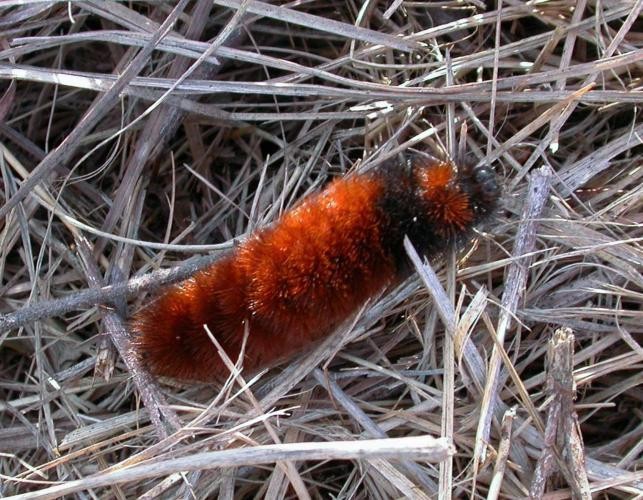Isabella tiger moth
(Pyrrharctia isabella)

Description
Pyrrharctia isabella, the isabella tiger moth, whose larval form is called the banded woolly bear, woolly bear, or woolly worm, occurs in the United States and southern Canada. It was first formally named by James Edward Smith in 1797. The thirteen-segment larvae are usually covered with brown hair in their mid-regions and black hair in their anterior and posterior areas. In direct sunlight, the brown hair looks bright reddish brown. Adults are generally dull yellowish through orangish and have robust, scaly thorices; small heads; and bright reddish-orange forelegs. Wings have sparse black spotting. The isabella tiger moth can be found in many cold regions, including the Arctic. The banded woolly bear larva emerges from the egg in the fall and overwinters in its caterpillar form, when it literally freezes solid. First its heart stops beating, then its gut freezes, then its blood, followed by the rest of the body. It survives being frozen by producing a cryoprotectant in its tissues. In the spring it thaws. Larval setae do not inject venom and are not urticant; they do not typically cause irritation, injury, inflammation, or swelling. Handling larvae is discouraged, however, because their sharp, spiny hairs may cause dermatitis in some people. When disturbed, larvae defend themselves by playing possum (rolling up into balls and remaining motionless) and quickly crawling away. This species is a generalist feeder, consuming many plant species, including herbs and trees. Based on the caterpillars' wide range of food plants, this moth could be found almost anywhere that plants grow. Singer et al showed that the larvae of a related moth, Grammia incorrupta (whose larvae are also called "woollybears"), consume alkaloid-laden leaves that help fight off internal parasitic fly larvae. This phenomenon is said to be "the first clear demonstration of self-medication among insects." Within the same family, the larvae of the garden tiger moth (Arctia caja) are also known as woollybear caterpillars and consume an alkaloid diet similar to Grammia incorrupta. Canadian and U.S. folklore holds that the relative amounts of brown and black hair on a larva indicate the severity of the coming winter. It is believed that if a Pyrrharctia isabella's brown band is wide, winter weather will be mild, and if the brown band is narrow, the winter will be severe.
Taxonomic tree:







